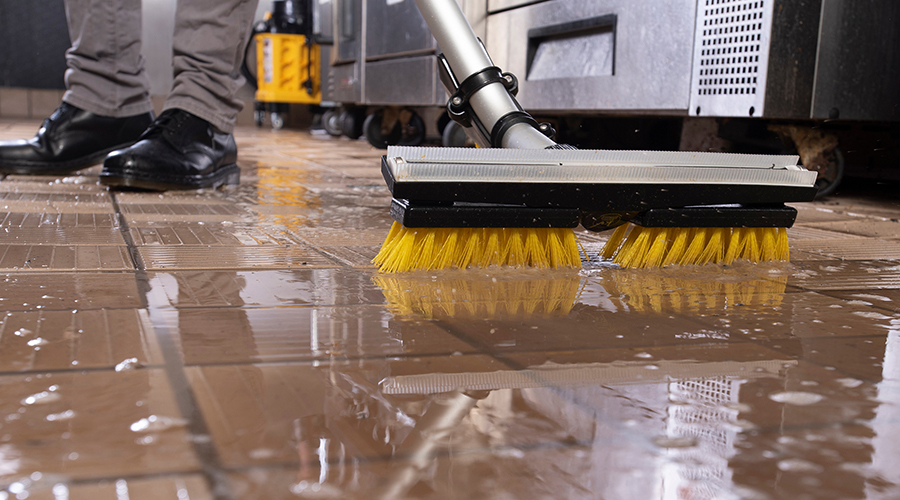SPONSORED
Kaivac - Branded Feature
A Facility Manager’s Guide to Cleaning Chemicals
Cleaning chemicals can be complicated. There’s a different cleaning agent for every job and that boils down to lots of choices that must be made. But facility managers should choose wisely. Use the wrong product and results will suffer. Use the right product incorrectly, and, again, results will suffer. This guide to the best cleaning chemicals will help facility managers make the right choice and provide best practices for using a variety of products.
Types of Cleaning Chemicals

All-purpose cleaning agents contain a mixture of surfactants and other sequestering agents. They tend to be pH neutral or weakly alkaline, which makes them safe for use on most hard surfaces. However, some all-purpose cleansers contain abrasives that may scratch surfaces over time, leaving them dull and harder to clean. A non-abrasive all-purpose cleaner, KaiO™ from Kaivac, combines orange oil with hydrogen peroxide to make an environmentally-responsible, multipurpose pH neutral cleaner.
Acidic cleaning agents effectively remove inorganic deposits like hard water scaling, mineral deposits or soap scum. This makes these agents perfect for use in restrooms. Their high pH also makes them a good choice for neutralizing and removing road salts tracked in during the winter months. KaiBlooey™ from Kaivac is an acidic cleaning agent and a favorite for restroom cleaning.
Alkaline cleaning agents eadily dissolve fats, grease, oils and protein-based soils. These cleaning solutions work well in food service and food processing. They are also appropriate in industrial applications where greasy soils are prevalent. KaiPow™ from Kaivac is an alkaline cleaning agent designed for commercial kitchens and heavy grease loads.
Disinfect Versus Sanitize
The general public may use the terms disinfect and sanitize interchangeably, but there is a quantifiable, legal difference between the two terms. In the US, sanitizers are agents that destroy 99.999 percent of bacteria in 30 seconds during the Official Detergent Sanitizer Test. Disinfectants kill all organisms in 10 minutes during the EPA-regulated AOAC Use Dilution Test.
Both methods go a step further than standard cleaning as they remove potentially harmful agents that may be left behind. Both also require that all dirt and debris be fully removed before beginning the process.
"Germs can hide underneath dirt and other material on surfaces where they are not affected by the disinfectant,” according to the EPA. And it gets worse. “Dirt and organic material can also reduce the germ-killing ability of some disinfectants."
Sanitizing is appropriate for surfaces that come into contact with food. They are also a good choice for items that might end up in a child’s mouth like toys or pacifiers.
There are many types of EPA-registered disinfectants like chlorine, alcohols, and quaternary ammonium compounds or QUATS. They are identified with a number and have verifiable kill claims on their label along with explicit instructions on their use. Disinfectants work best on hard, non-porous, non-finished surfaces like:
- Toilets, urinals, diaper pails
- Porcelain tile and restroom fixtures
- Food contact surfaces, preperation areas and storage areas
- Sinks, floors, walls, countertops, bathtubs, shower stalls, doors and more
How to Disinfect Correctly

While there may be an impulse to use a generous amount of product, less is more when it comes to disinfectants. Bleach irritates skin and eyes. QUATS have been linked to asthma and other autoimmune deficiency problems. Use too much on your floors and they will be sticky and discolored. Dilute as directed on the label and the product will work optimally.
Follow use instructions on a disinfectant carefully too. In fact, it is a violation of federal law to use a disinfectant in a manner inconsistent with its labeling. One critical step that is often overlooked is to properly clean the surface prior to applying the disinfectant, removing all soils and debris. Another important consideration is dwell time, where the product stays on a surface without drying, often for up to 10 minutes to effectively kill microbes. If the surface is allowed to dry it must be retreated and the clock starts again. Then follow instructions for rinsing and drying.
Diluting Cleaning Chemicals the Right Way
Industrial cleaning chemicals are sold in concentrated form and need to be diluted with water before use. Manually mixing them, using something called the ‘glug-glug’ method, is not acceptable as it can cause costly and dangerous mistakes according to CleanLink.
Too much water will render the cleaning agent ineffective. A maintenance professional using the improper amount could end up spreading pathogens throughout the entire building.
Too much chemical can be just as dangerous and costly too. Excess product can splash and release fumes that impacts indoor air quality. It can leave floors sticky or damage expensive surfaces. Residue from too much chemical builds up over time and is difficult to remove.
Follow manufacture guidelines for the optimal dilution rate. Automatic diluters are more accurate than ‘glug-glug’ methods, but they tend to be costly and prone to mechanical problems. Pre-portioned cleaning packets eliminate waste and guesswork, simplify training, and are easy to transport and use.
Green Chemicals and Sustainable Cleaning Methods

While using green chemicals is a good step forward, truly sustainable cleaning takes the concept even further. Sustainable cleaning methods rely mostly on process, not chemicals, to create clean surfaces. Then when chemical cleaners, disinfectants, and sanitizers are used, they are used more sparingly and when they are needed most.
Three Kaivac products: KaiO all-purpose cleaner, UniVac®,and the AutoVac Stretch™ hard floor cleaning systems have been certified by Green Seal. Green Seal is an independent, nonprofit entity that certifies products and services that are proven to be sustainable according to their rigorous standards. Kaivac systems have been certified because they capture and remove contaminants, pollutants, and pathogens while drastically reducing water and chemical usage. They clean in a highly sustainable way while creating spotless, healthy facility spaces.











